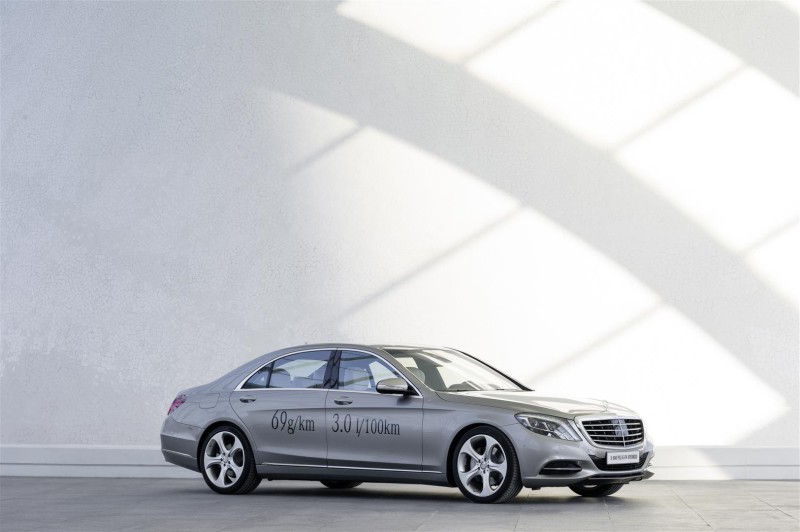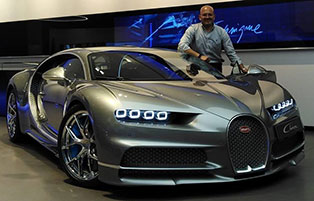MercedesBenz
Mercedes-Benz aims for zero-emission driving with CO2 saving at full speed
Mercedes-Benz is working by the principle 'consumption and emissions reduced, driving enjoyment increased' by continuously improving the efficiency of all of its models, thereby saving fuel for the customer and sparing the environment a significant amount of impact from emissions.
As a result, the brand is today one of the most efficient in the premium segment and has set the benchmark in many vehicle classes with regard to consumption and emission levels.
In terms of specific figures, more than 50 Mercedes-Benz models emit less than 120 g CO2/km, and more than 100 models bear the energy efficiency label A+ or A.
Furthermore, at this year’s IAA international motor show in Frankfurt, Mercedes-Benz presented the S 500 PLUG-IN HYBRID, which emits just 69 g CO2/km – an optimum value which until recently was considered unimaginable. In 2013 the average CO2 emissions of the entire European new car fleet produced by Mercedes-Benz Cars had, by November 2013, already fallen to 134 g/km.
Mercedes-Benz has been working intensively from the very outset on
With an average for the fleet of 134 g/km the Stuttgart-based automotive manufacturer has succeeded in repeating its above-average reduction in CO2 output in 2013 too. This corresponds to a reduction of more than 40 percent compared with 1995 and is the largest of all premium car manufacturers.
"In 2012 our CO2 fleet output was 140 grammes. We have now undercut this figure by a further 6 grammes. And one thing is certain - we will strive to reduce our CO2 emissions on a continual basis. Ultimately we have set ourselves the ambitious target of achieving an average CO2 fleet output of 125 g CO2/km by 2016", explains Professor Thomas Weber, Daimler Board Member responsible for Group Research and Mercedes-Benz Cars Development.
In terms of fuel consumption, this means that overall the petrol and diesel engines of Mercedes-Benz Cars currently consume an average of around 3.5 to 4 litres less per 100 km than at that time. Viewed in terms of an average annual mileage of 15,000 kilometres, this corresponds to an annual saving of significantly more than one tonne of CO2, or almost 600 litres of fuel per newly registered vehicle. Environmental awareness therefore has significant benefits for the wallet too.
More power, less thirst:
When modern engines are tuned for greater efficiency, for technical reasons their performance also increases significantly at the same time. For example, in 1995 the E 200 consumed 8.2 litres per 100 kilometres in the Euro-Mix cycle which was still applicable at that time (corresponding to approx. 9.0 litres according to NEDC), with an output of 100 kW (136 hp). By way of comparison, over the same distance the current E 200 consumes 5.8 litres (NEDC combined) and has an output of 135 kW (184 hp).
The efficiency rating is even better for the diesel engines: in 1995 the E 220 diesel consumed 6.6 litres in the Euro-Mix cycle (corresponding to approx. 7.2 litres according to NEDC) and had an output of 70 kW (95 hp). The modern E 220 BlueTEC BlueEFFICIENCY Edition achieves a consumption of 4.4 litres of diesel per 100 kilometres (NEDC combined) and a peak output of 125 kW (170 hp).
At the same time, with emissions of 114 grammes of CO2 per kilometre, the E 220 BlueTEC BlueEFFICIENCY Edition not only achieves an optimum value in its segment, but also already complies with the future Euro 6 emissions standard and is consequently classified in the best efficiency class, namely A+. Offering superior performance, it is also proof that ecology and temperament can go hand in hand. The efficient saloon accelerates from 0 to 100 km/h in 8.4 seconds and reaches a top speed of 227 km/h.
The E 300 BlueTEC Hybrid emits even less CO2. It combines a 150 kW four-cylinder diesel engine with a 20 kW electric motor and on average consumes just 4.1 litres of fuel (NEDC combined), which corresponds to CO2 emissions of 107 grammes per kilometre.
Mercedes-Benz is also optimising efficiency in other vehicle classes too. For example, the A 180 BlueEFFICIENCY emits just 92 g of CO2 per kilometre – around 24 percent less than its predecessor. And the GLA 220 CDI 4MATIC boasts what for a four-wheel drive vehicle is an exemplary figure of 129 grammes per kilometre, and as such is the best in its class.
Best in class - the S-Class as a "three litre" car:
With the S 500 PLUG-IN HYBRID, Mercedes-Benz is setting new benchmarks in terms of efficiency. At 69 grammes of CO2 per kilometre (corresponding to 3.0 litres of fuel per 100 km according to NEDC), the hybrid model presented at the IAA international motor show in Frankfurt achieves a record level of consumption for luxury saloons which until recently was considered to be impossible.
Its powerful 80 kW electric drive with externally rechargeable battery makes emission-free driving possible over a range of approximately 30 kilometres. It is combined with a 3.0-litre V6 turbo engine with an output of 245 kW. As such the most economical S-Class model ever completes the sprint from 0 to 100 km/h in 5.5 seconds, and hits a top speed of 250 km/h.
In addition, numerous other models from the A-Class, GLA, C-Class, E-Class, S-Class, GLK and the M-Class have also achieved "best in class" status. In total, some 23 models from Mercedes-Benz currently lead the field in their premium segment when it comes to efficiency. Mercedes-Benz Cars offers a total of more than 50 models emitting less than 120 g CO2/km.
The efficiency label classification system, as already commonly applied to household appliances and, since December 2011, also designed to make purchasing a car easier, serves to highlight the benchmark position of the Mercedes brand. Currently some 86 models from Mercedes-Benz Cars bear the "A" label, while a further 20 have even earned the "A+" label. And this is a trend which is on the increase.
Innovative technology for significant savings in real-world consumption conditions:
With the focus on real-world consumption, the world's oldest automotive manufacturer is also consistently investing in measures which, despite having no effect on reducing consumption as measured in the NEDC cycle, do in fact bring about quite significant savings when it comes to actual customer operation.
One such area is vehicle aerodynamics, for example. Even from a speed as low as 60 km/h, wind resistance reaches such a level that it can have a significant effect on fuel consumption. The scale used to measure this is the Cd value. A reduction of this value by 0.01 translates into one gramme less of CO2/km in the driving cycle (NEDC), while in average real-world consumption conditions it can equate to two grammes, and at 150 km/h even as much as five grammes of CO2 per kilometre.
Mercedes-Benz is one of the leading companies in the field of aerodynamics and delivers cars with some of the best values in almost all vehicle classes.
Current examples include the CLA which boasts the world's best Cd value for a series production vehicle of 0.22, and the new S-Class with a Cd value of 0.23. When it comes to compact models too, such as the new A-Class (2012, Cd 0.26), coupés such as the E-Class Coupé (2010, Cd 0.24), saloons such as the E-Class (2009, Cd 0.25), sports cars such as the SL (2012, Cd 0.27) and SUVs such as the M-Class (2011, Cd 0.32), vehicles in these segments have never before achieved such low Cd figures.
With the GLA, yet another model series is set to become the leader in its segment with respect to aerodynamic efficiency. It has a Cd value of 0.29. These examples show that exciting, sensual design and high aerodynamic efficiency need not be contradictory concepts.
Also making a contribution to the increase in efficiency are the engines and drive systems. These include the four, six and eight-cylinder BlueDIRECT petrol engine family featuring a lean burn process with stratified charge operation, precisely controlled multiple injection as well as "rapid multi-spark ignition" (MSI). Mercedes-Benz diesel engines, too, represent the pinnacle of technological development with their fourth-generation common rail technology.
Mercedes-Benz combines both petrol and diesel engines with on-demand controlled ancillary equipment, such as oil and coolant pumps for example, and also fuel-efficient components such as power steering and the ECO start/stop system. Given that the 7G-TRONIC seven-speed automatic transmission already makes a significant contribution to the economic use of fuel, then the first nine-speed automatic transmission with torque converter for premium vehicles, the 9G-TRONIC, is all set to enhance efficiency even further. It recently celebrated its world premiere in the E 350 BlueTEC, helping to reduce NEDC fuel consumption of the six-cylinder diesel engine, with an output of 185 kW (252 hp), to 5.3 litres per 100 kilometres (CO2 emissions of 138 g/km).
Investments in green technology:
To reduce on-the-road consumption in everyday practical use Mercedes-Benz is continually developing new methods, such the "energy-transparent vehicle" development tool for example. Using its approximately 300 measurement points, Mercedes-Benz development engineers are able to carry out a precise and meticulous examination of the flow of energy throughout the vehicle (tank to wheel). This enables them to optimise the energy efficiency of even the most minute component and therefore significantly improve the overall efficiency of Mercedes-Benz vehicles.
"Every year, we invest around six billion euros in the research and development of our passenger car models, with around half of that amount being invested in green technologies. That investment is paying off. We have made a giant leap forward in the area of CO2 emissions in particular, and have achieved this in all vehicle segments", explains Prof. Thomas Weber. "Our specifications for forthcoming new models include a number of measures designed to reduce consumption further, such as in the areas of lightweight construction or aerodynamics for example".
Although most of the consumers in the Middle East and North Africa do not pay much attention to fuel-efficient and low-emission cars yet, it is good to know that Mercedes-Benz is well-prepared when this attitude (hopefully) changes soon.
MS
11.12.2013
Stuttgart - Dubai - Cairo
Related articles:
#SaferCarsForEgypt
 Want to sell your used car or buy one? Then check out our new used car market section
here!
Want to sell your used car or buy one? Then check out our new used car market section
here!
 Looking for a good service center or aftersales customer service? Did you have any bad experience with your car dealer or service center? Then check our 'automotive evaluation charts'
here!
Looking for a good service center or aftersales customer service? Did you have any bad experience with your car dealer or service center? Then check our 'automotive evaluation charts'
here!
Is Egyptian car market corrupt or collapsing?

Is the Egyptian car market collapsing or is it just a corrupt and unprofessional car market?
This is surely one of the most asked questions these days. Everybody is asking ...
AutoArabia Consulting
Middle East Car of the Year

Read more
Crash Test Results

Subscribe




 Volvo Cars receives highest possible sustainability ...
Volvo Cars receives highest possible sustainability ... Mercedes Benz Egypt: Questionable sales practices and ...
Mercedes Benz Egypt: Questionable sales practices and ... BMW Middle East partners with Art Dubai
BMW Middle East partners with Art Dubai LAND ROVER’S 70TH ANNIVERSARY BEGINS WITH RESTORATION ...
LAND ROVER’S 70TH ANNIVERSARY BEGINS WITH RESTORATION ... BMW M5 WINS THE 2018 WORLD PERFORMANCE CAR AWARD AT WCA
BMW M5 WINS THE 2018 WORLD PERFORMANCE CAR AWARD AT WCA Good news for BMW customers in Egypt: BMW headquarter ...
Good news for BMW customers in Egypt: BMW headquarter ... BMW recalls 150.000 vehicles because of possible fuel ...
BMW recalls 150.000 vehicles because of possible fuel ... The disappointed customers and over-pricing of BMW ...
The disappointed customers and over-pricing of BMW ... Bad start for Mercedes E-Class in Egypt: Daimler ...
Bad start for Mercedes E-Class in Egypt: Daimler ... Mercedes Benz E180 in Egypt – Top or Flop?
Mercedes Benz E180 in Egypt – Top or Flop?




